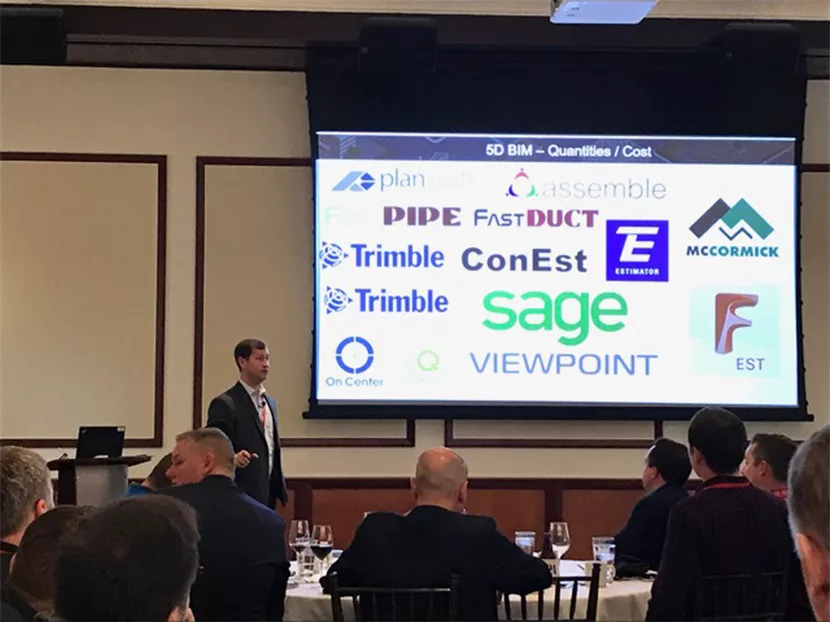Construction and building data exists for almost every project that has ever been built, but harnessing the power of that data through digital avenues is becoming more commonplace in the industry.
“It’s exciting to watch technology continually evolve in the construction industry, and see how our members respond to the newest advances,” said Tony Adolfs, executive vice president of SMACNA Greater Chicago. “As an association, we’re committed to providing our members with the resources they need be leaders in our industry.”
In their continuing efforts to help members stay aware of emerging technologies, SMACNA provides regular educational programs for members. Recently Josh Bone, a DeWalt construction technology specialist, spoke to a group of nearly 70 SMACNA Greater Chicago members on the topic of trending technology and the future of data collection during the association’s recent membership meeting.
From Bone’s presentation, SMACNA members learned five ways to help their firms thrive by capitalizing on the wealth of construction data available to them.
Helps recruit a new generation of employees: Millennials are tech-savvy. They grew up with the Internet, and are used to information at their fingertips.
“The last thing millennials want to do it fill out paper-based reports,” Bone said. “Companies are digitizing workflows and taking the laborious task out of the process, and it’s definitely helping them recruit and retain much younger talent. I can say I’ve seen SMACNA members across the country who’ve increased their use of prefabrication, increased their use of BIM and are leveraging big data, and they’ve done a really good job of retaining top talent.”
For an industry on the verge of a crippling labor shortage — both in the office and the field — utilizing new technologies and data solutions can be key to onboarding new talent.
Encourages collaboration: There’s still a place for paper blueprints in the field, but the rise of technology allows teams to visualize entire projects from the design phase all the way through construction, gaining valuable insights from compiled data. Data can now be collected throughout the lifecycle of any given project and shared in real time, improving field and office communications. Compiled data can easily be used to streamline your bidding process, standardize your workflows and track and predict future outcomes on projects.
Reduces risk to deliver better outcomes: When projects are delayed — whether by human error, weather or other factors — money is lost. By using data analytics, stakeholders can view real-time status reports and project information to determine things like potential risk factors and profitability. The more data that is collected over a project’s lifetime, the more actionable intelligence is gained that can be applied to future projects.
Increases efficiency and productivity: Construction companies often juggle many complex projects at once. Information collection, management and analysis for so many moving parts can cause delays and create headaches — but new software solutions designed specifically for our data-rich industry make it possible for companies to process and use large amounts of data.
Construction professionals have used building information modeling (BIM) for a number of years, but it is only recently taking hold and beginning to transform the industry because of its data collection and storage capabilities.
“BIM is an invaluable tool in sheet metal fabrication. Our fabrication drawings and data can integrate directly with collaborative software, making the communications and manufacturing processes easier,” said Joe Passannante, president of SMACNA Greater Chicago and vice president of operations at Cleats Manufacturing.
BIM and CAD programs save time by detecting errors that could cause changes and rework down the road, allowing companies to focus their energy on successful project delivery.
Improves worksite safety: Data can help predict risks on the jobsite, and can easily integrate with and make existing safety programs better.
With today’s widespread use of mobile technology, it’s as easy as installing an app that make sense for your project or firm. StriveZero, Safesite and iAuditor are just a few of the apps available to help raise safety standards within your organization. Conduct inspections, log incident reports and perform risk assessments all from your phone or tablet.
“I’ve seen data play a critical role in reducing safety incidents,” Bone said. “The great thing now is there is so much you can do on your mobile devices. Take advantage of these tools that are already available to you.”
Whether you’re a small firm or a large industry leader, embracing today’s technology has never been easier, or more important. The vast amounts of data collected from BIM, apps, wearable devices and more can help streamline every process — from design, to construction, to service — keeping your organization competitive and increasing your profits.




